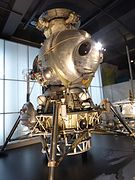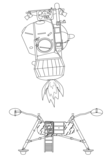LK (spacecraft)
OKB-586 | |
| Designer | Mikhail Yangel |
|---|---|
| Country of origin | Soviet Union |
| Operator | Soviet space program |
| Applications | Crewed lunar landing |
| Specifications | |
| Spacecraft type | Lunar module |
| Launch mass | 5,560 to 6,525 kg |
| Crew capacity | 1 (2 on later variant) |
| Dimensions | 5.20 to 5.8 m high 4.50 m wide overall, landing gear deployed |
| Volume | 5 m3 |
| Power | N2O4/UDMH |
| Batteries | Equipped |
| Regime | Lunar orbit |
| Design life | 48 hours |
| Production | |
| Status | Canceled |
| Built | Several |
| Launched | 3 (T2K variant) |
| Maiden launch | N2O4[1] |
| Configuration | |
 LK components: 1) passive plate of the docking system, 2) attitude control nozzles, 3) orbital rendezvous window, 4) landing window (in a concave recess), 5) high-gain antennas, 6) solid-fuel "nesting" engines, 7) footpads, 8) omnidirectional antenna, 9) rendezvous radar, A) pressurized compartment, B) equipment compartment, C) hatch, D) batteries, E) engine and fuel tanks, G) ladder | |
The N1-L3 flight plan
Lunar orbit
The
Lunar landing
An earlier uncrewed probe of the Luna programme, a Lunokhod would be used to select a suitable area, and then act as a beacon for the LK. A backup LK would then be launched to the landing site. The third step would see a crewed LK landing with a single cosmonaut.
Although the specifics on planned activity while on the lunar surface remain vague, the small size and limited payload capacity of the N-1/Soyuz LOK/LK compared to the Saturn/Apollo meant that not much in the way of scientific experiments could have been performed. Most likely, the cosmonaut would plant the
Earth return
After a day on the lunar surface the LK's engine would fire again, using its landing leg structure as a launch pad. To save weight, the engine used for landing would also blast the LK back to lunar orbit for an automated docking with the LOK, using the
Design
The LK spacecraft can be subdivided into the lunar landing aggregate ("Lunnyi Posadochnyi Agregat", "LPA") and the lunar ascent vehicle, ("Lunnyi Vzletnyi Apparat", "LVA'").[3] Propulsion, both for landing and lifting off the Moon was based on the Blok E propulsion system. The Information Display System (spacecraft control panels and controls) version was called Luch.
The four missions using an LK used the T2K variant, almost identical to the standard LK, but without landing gear.
Systems
The spacecraft included the following systems:[3]
- Pressurized cosmonaut compartment;
- Flight control avionics;
- Life-support system;
- Attitude control systems;
- Lunar landing device, or LPU, with four landing legs;
- Power supply system, consisting of chemical batteries attached to LPU;
Instruments
The spacecraft included the following instruments:[3]
- Planeta landing radar
- pressurized avionics container
- two communication antennas
- three batteries
- four containers with water for a vaporization unit
- robotic arm and drill
Testing
The LK variant T2K was tested uncrewed in Earth orbit over three missions[4] as Kosmos 379,[5] Kosmos 398 and Kosmos 434. The first test was on November 24, 1970, the second on February 26, 1971, and the third on August 12, 1971. All three LKs were launched with the Soyuz-L rocket. The first flight imitated the planned working cycle of the Blok E stage. The second and third flights were intended to test the LK's behavior under several flight anomalies. All flights went well, and the LK was considered ready for crewed flight.[2]
Cancellation
The success of the
In 2017, there was an anonymous claim that Chinese officials asked the Ukrainians to rebuild the very original LK's propulsion module using modern materials like new computer technology replacing obsolete electronics in the module's flight control system. According to the agreement, Ukrainians will transfer China the newly produced set of design documentation for the propulsion module, but the hardware itself will remain in Ukraine. In the future, Ukrainians might assist the Chinese in organizing the production of the technology in China, sources said.[7]
LK compared to the Apollo Lunar Module
Because the payload capacity of the N1 rocket was only 95 tons to
- It had a different landing profile
- It was lighter at only one-third the mass of the LM
- Initially the LK was to have carried a single cosmonaut. A later variant would have a two-man crew; the LM carried two
- It had no docking tunnel like the LM's; the cosmonaut would LOK (Soyuz 7K-L3)to the LK and back.
- To leave lunar orbit and begin descent, the LK used the same braking stage, the Blok D, which put the LK-Soyuz stack into lunar orbit; the LM used its landing stage engine (later Apollo missions also used the SPS engine to help deorbit the LM).
- The final deceleration, from a velocity of 100 m/s at an altitude of 4 km above the lunar surface, was done with a Blok E stage, capable of multiple restarts. This allowed the Blok E to also serve as the ascent stage to return the LK to lunar orbit; the LM's landing stage had a dedicated engine for landing.
- For better performance, LK Blok E engines used turbopumps to provide them with fuel components. Solid charges were used for quick activation of the pumps that limited the number of ignitions.
- After landing the LK landing gear structure was designed to serve as a mini-launch complex for the upper stage's lift-off; the Apollo LM used its descent stage in the same fashion.
- The LK Blok E had both primary and reserve engines allowing for reassurance of ascent; the Apollo LM lifted off with a single ascent engine, and had no backup or reserve but was designed for simplicity and reliability allowing for optimal assurance of ascent. A failure of the LM ascent engine would guarantee a critical mission failure.[2]
Current location
There are five remaining LK in various stages of completion. They are at:[2][8][9]
- Moscow Aviation Institute (temporarily displayed at Disneyland Paris)[9]
- Orevo Research and Educational Facility of Bauman University in Dmitrov
- RKK Energia plant at Korolev
- Tambov air base
- St Petersburg
- London Science Museum “Cosmonauts” exhibition (2016)[8]
-
A LK lander at theRKK Energia plant, 2016
-
LK-3 engineering test unit, Science Museum, 2016
See also
- Zond program
- Apollo 18 (film)
- Single-person spacecraft
- List of crewed lunar lander designs
- Apollo Lunar Module
- Chinese crewed lunar lander
References
- ^ "LK". www.astronautix.com. Archived from the original on August 20, 2016.
- ^ a b c d "LK". www.astronautix.com. Archived from the original on 2016-08-20. Retrieved 2023-10-24.
- ^ a b c "Lunar Module (LK)". Archived from the original on 2013-12-30. Retrieved 2013-12-15.
- ^ "LK". Archived from the original on 2009-04-18.
- ^ "NASA Space Science Data Coordinated Archive". Archived from the original on 2021-01-09. Retrieved 2019-08-21.
- ^ Mark Franchetti (July 3, 2005). "Russia plans first men on Mars". The Times. London. Archived from the original on 2024-02-24. Retrieved 2008-02-05.
- ^ Zak, Anatoly (19 June 2017). "Long Abandoned Soviet Tech Might Help China Land on the Moon". Popular Mechanics. Archived from the original on 17 January 2021. Retrieved 18 September 2019.
- ^ a b admin (2016-02-20). "Soviet LK Moon lander". Nick Stevens Graphics. Archived from the original on 2023-10-01. Retrieved 2023-10-24.
- ^ a b "Soviet Manned Lunar Program Gallery". www.ninfinger.org. Archived from the original on 2021-07-08. Retrieved 2023-10-24.







